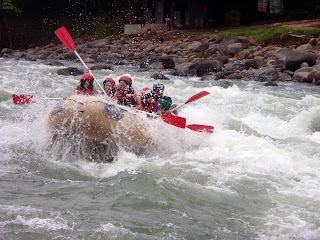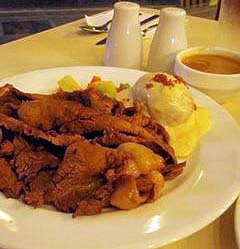

If you’re looking for a trip that’s out of the ordinary, a real adventure off the beaten track, then Batad is just the place for you. In the vast Cordillera Mountain Range, you can find this awe-inspiring stairway to heaven. But to get to this paradise, you have to tough it out and just keep on walking till your feet ache and your whole body is stiff. But I promise, when you see the majestic amphitheater-like rice terraces of Batad, you’re efforts will be well worth it.
Going there, we took the Autobus from Manila to Banaue, which cost P450 per person. The trip will take approximately 9 hours. When we arrived in Banaue, we found out that there will be no jeepneys traveling to Batad that day. So we decided to hire a tricycle that would take us as far as Batad Junction, and then from there, we had to hike the rest of the way.
As the sun started to get higher, the trek uphill got harder. We were walking on rough roads, occasionally passing through landslide debris. For two hours we kept on trudging and with each step the weight of my backpack seemed to get heavier. Until finally we reached a small hut where a young Ifugao was waiting. He introduced himself as Melo and inquired if we needed a guide/porter. We negotiated the fee for his services and agreed at P600. Glad to be relieved from my backpack, the walk to Saddle Point seemed like a breeze.
At Saddle Point, there are sari-sari stores that sell 
So after more or less 4 hours of walking, we finally reach Batad. Panting, sweating and hungry but utterly amazed at what lay before my eyes. The mountain range forms a huge amphitheater and carved on its slopes are the 2,000 year old rice terraces. I was stunned and speechless at this man-made marvel. After a few minutes of just taking in the splendor of this ancient engineering feat, a word finally escaped from my mouth, “Wow!!”.
There are several inns in Batad and we chose to stay in Hillside Inn because it seemed to have the best view of the terraces. An overnight stay here plus lunch and dinner cost us P615. Don’t expect 5-star luxury here, though, it’s as basic as basic can get. After a quick bite and a short power nap, we felt recharged and headed to Tappia Falls.
It started to drizzle as we walked to Tappia Falls. The terraces were covered in fog and mist. We had to balance on the narrow stonewalls of the terraces. If you slip, you could fall 10 feet down. Being up close the terraces, you see how massive it is and you begin to imagine how the ancient Ifugao tribes carved the mountain slopes and how they c
We reach Tappia Falls around dusk. We take a quick dip in its freezing cold water. It refreshes us.
And as we walk back to the inn, the sun starts to set. We watch the sky change colors. Like a vast curtain, the sky cloaks the amphitheater terraces in purple then dark blue and finally... in darkness.
































